Impact of Macroeconomic Factors on Housing Prices in Australia
VerifiedAdded on 2023/01/19
|5
|798
|54
Report
AI Summary
This report provides an analysis of the Australian housing market, focusing on the impact of key macroeconomic factors on housing prices in major capital cities. It begins with an overview of the volatility in the Australian housing market and its connection to macroeconomic variables such as real GDP, inflation, employment, and population growth. The report then delves into the influence of inflation, unemployment, and population growth on housing prices, drawing on existing research and theoretical frameworks. The study aims to evaluate the impact of inflation, unemployment, and population on housing prices in Australia's major capital cities. The paper includes a mind map for conceptual clarity and references relevant research papers to support its findings.
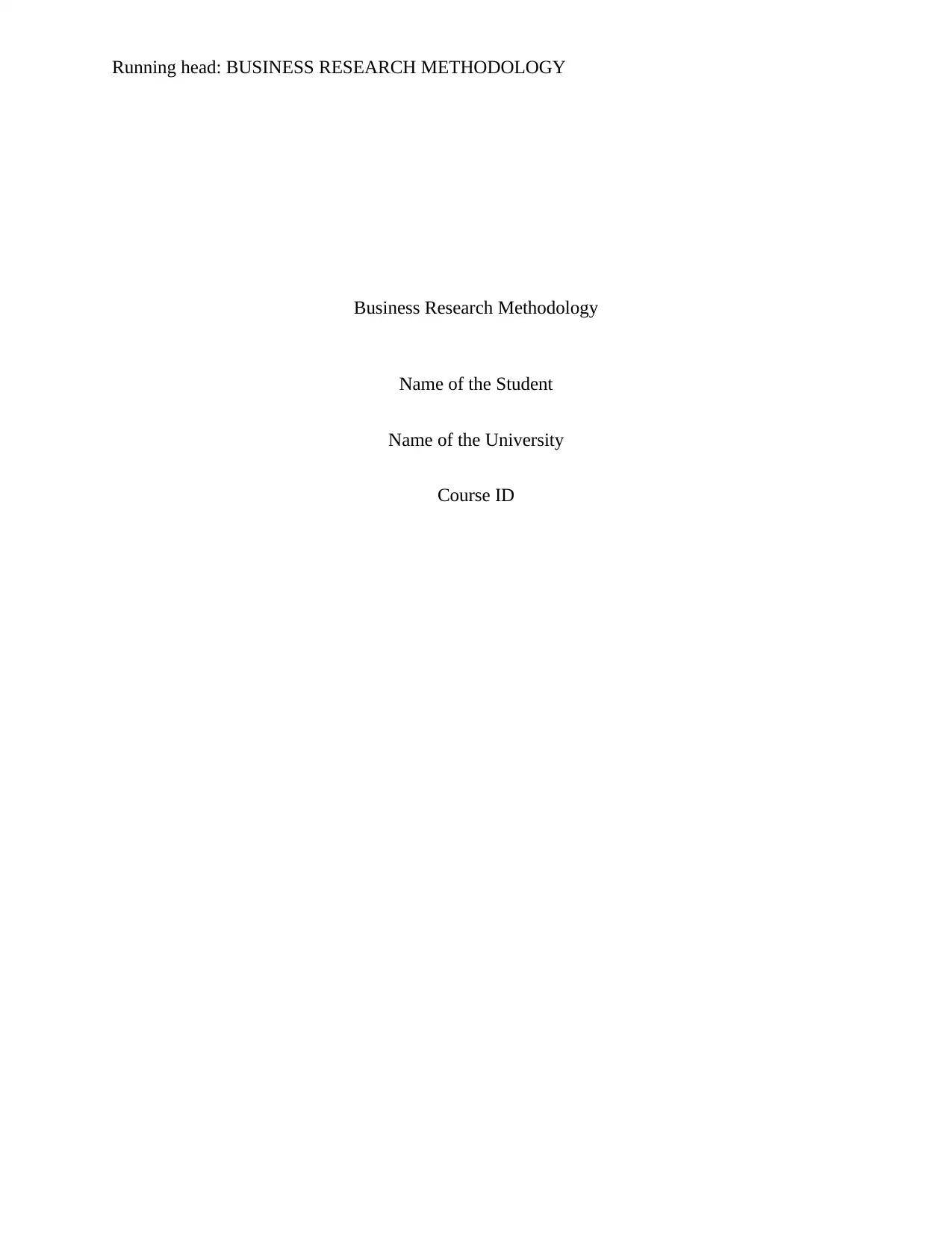
Running head: BUSINESS RESEARCH METHODOLOGY
Business Research Methodology
Name of the Student
Name of the University
Course ID
Business Research Methodology
Name of the Student
Name of the University
Course ID
Paraphrase This Document
Need a fresh take? Get an instant paraphrase of this document with our AI Paraphraser
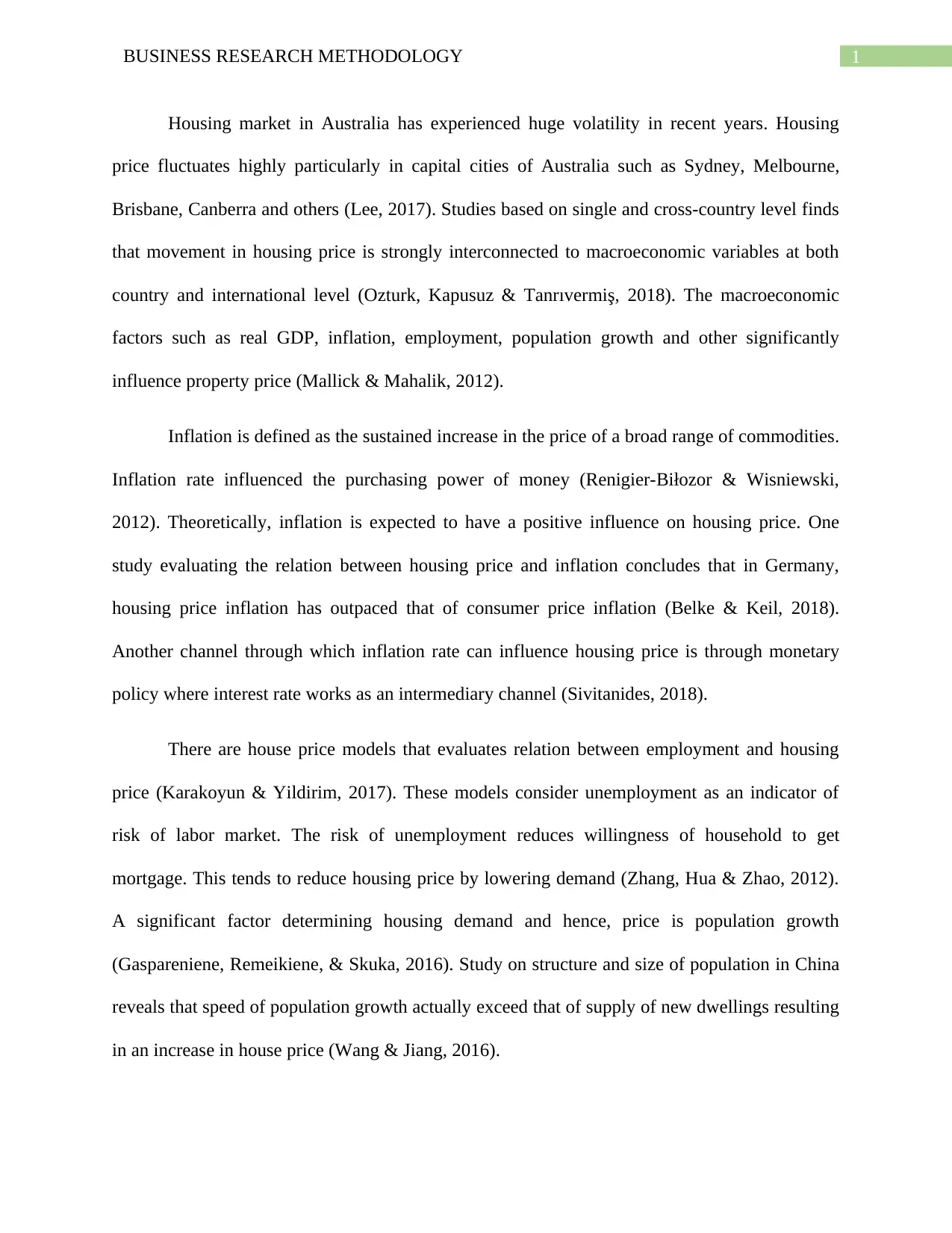
1BUSINESS RESEARCH METHODOLOGY
Housing market in Australia has experienced huge volatility in recent years. Housing
price fluctuates highly particularly in capital cities of Australia such as Sydney, Melbourne,
Brisbane, Canberra and others (Lee, 2017). Studies based on single and cross-country level finds
that movement in housing price is strongly interconnected to macroeconomic variables at both
country and international level (Ozturk, Kapusuz & Tanrıvermiş, 2018). The macroeconomic
factors such as real GDP, inflation, employment, population growth and other significantly
influence property price (Mallick & Mahalik, 2012).
Inflation is defined as the sustained increase in the price of a broad range of commodities.
Inflation rate influenced the purchasing power of money (Renigier-Biłozor & Wisniewski,
2012). Theoretically, inflation is expected to have a positive influence on housing price. One
study evaluating the relation between housing price and inflation concludes that in Germany,
housing price inflation has outpaced that of consumer price inflation (Belke & Keil, 2018).
Another channel through which inflation rate can influence housing price is through monetary
policy where interest rate works as an intermediary channel (Sivitanides, 2018).
There are house price models that evaluates relation between employment and housing
price (Karakoyun & Yildirim, 2017). These models consider unemployment as an indicator of
risk of labor market. The risk of unemployment reduces willingness of household to get
mortgage. This tends to reduce housing price by lowering demand (Zhang, Hua & Zhao, 2012).
A significant factor determining housing demand and hence, price is population growth
(Gaspareniene, Remeikiene, & Skuka, 2016). Study on structure and size of population in China
reveals that speed of population growth actually exceed that of supply of new dwellings resulting
in an increase in house price (Wang & Jiang, 2016).
Housing market in Australia has experienced huge volatility in recent years. Housing
price fluctuates highly particularly in capital cities of Australia such as Sydney, Melbourne,
Brisbane, Canberra and others (Lee, 2017). Studies based on single and cross-country level finds
that movement in housing price is strongly interconnected to macroeconomic variables at both
country and international level (Ozturk, Kapusuz & Tanrıvermiş, 2018). The macroeconomic
factors such as real GDP, inflation, employment, population growth and other significantly
influence property price (Mallick & Mahalik, 2012).
Inflation is defined as the sustained increase in the price of a broad range of commodities.
Inflation rate influenced the purchasing power of money (Renigier-Biłozor & Wisniewski,
2012). Theoretically, inflation is expected to have a positive influence on housing price. One
study evaluating the relation between housing price and inflation concludes that in Germany,
housing price inflation has outpaced that of consumer price inflation (Belke & Keil, 2018).
Another channel through which inflation rate can influence housing price is through monetary
policy where interest rate works as an intermediary channel (Sivitanides, 2018).
There are house price models that evaluates relation between employment and housing
price (Karakoyun & Yildirim, 2017). These models consider unemployment as an indicator of
risk of labor market. The risk of unemployment reduces willingness of household to get
mortgage. This tends to reduce housing price by lowering demand (Zhang, Hua & Zhao, 2012).
A significant factor determining housing demand and hence, price is population growth
(Gaspareniene, Remeikiene, & Skuka, 2016). Study on structure and size of population in China
reveals that speed of population growth actually exceed that of supply of new dwellings resulting
in an increase in house price (Wang & Jiang, 2016).
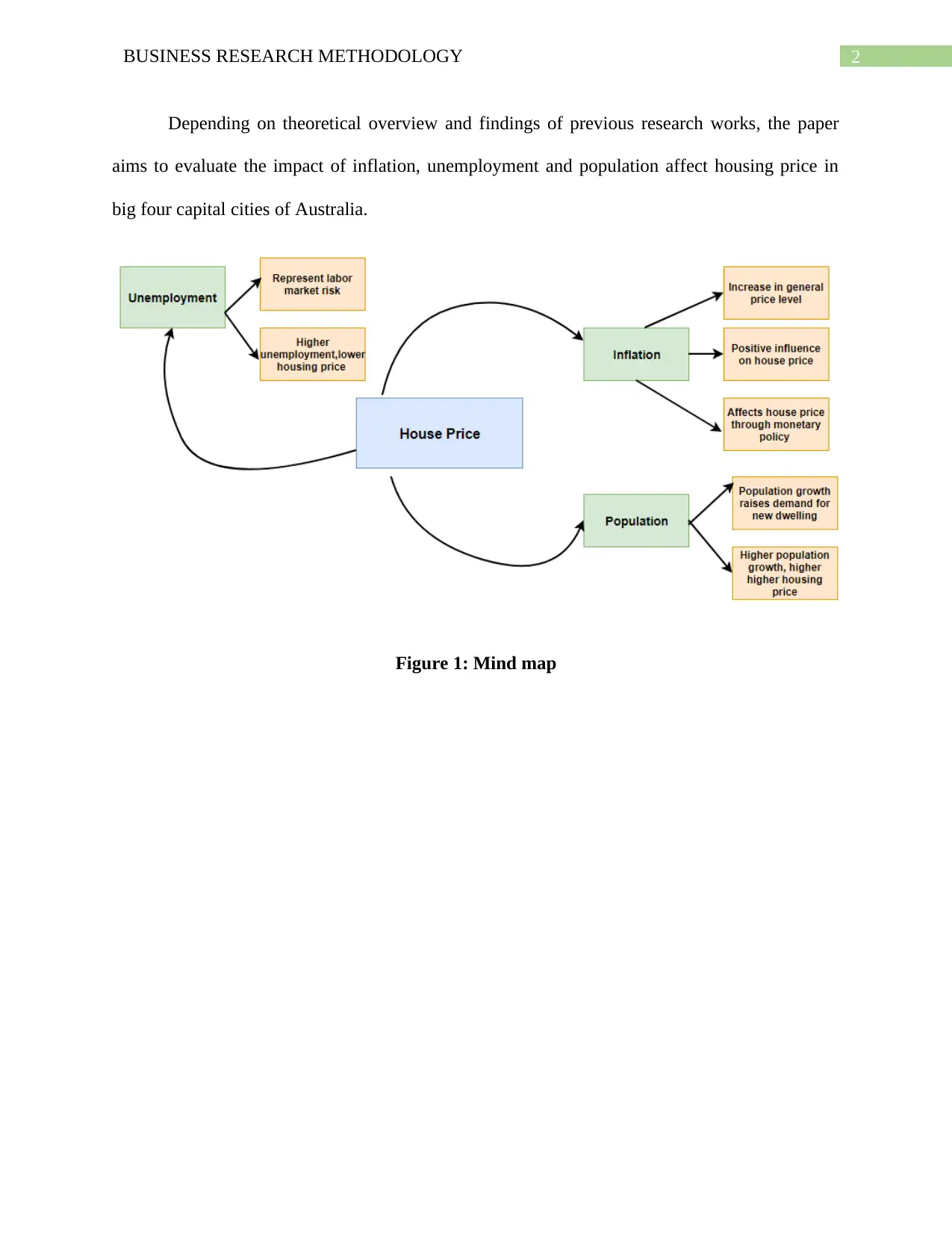
2BUSINESS RESEARCH METHODOLOGY
Depending on theoretical overview and findings of previous research works, the paper
aims to evaluate the impact of inflation, unemployment and population affect housing price in
big four capital cities of Australia.
Figure 1: Mind map
Depending on theoretical overview and findings of previous research works, the paper
aims to evaluate the impact of inflation, unemployment and population affect housing price in
big four capital cities of Australia.
Figure 1: Mind map
⊘ This is a preview!⊘
Do you want full access?
Subscribe today to unlock all pages.

Trusted by 1+ million students worldwide
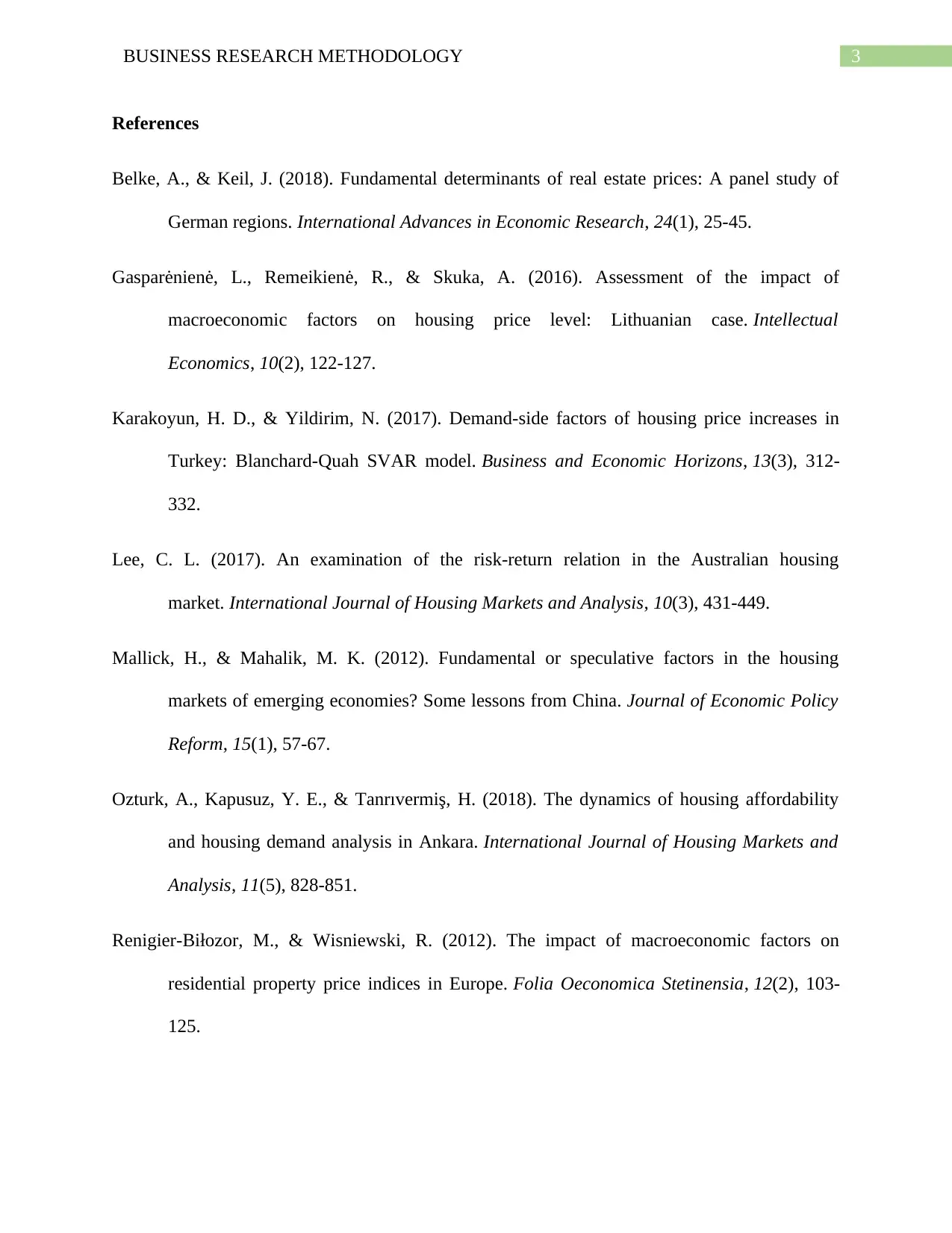
3BUSINESS RESEARCH METHODOLOGY
References
Belke, A., & Keil, J. (2018). Fundamental determinants of real estate prices: A panel study of
German regions. International Advances in Economic Research, 24(1), 25-45.
Gasparėnienė, L., Remeikienė, R., & Skuka, A. (2016). Assessment of the impact of
macroeconomic factors on housing price level: Lithuanian case. Intellectual
Economics, 10(2), 122-127.
Karakoyun, H. D., & Yildirim, N. (2017). Demand-side factors of housing price increases in
Turkey: Blanchard-Quah SVAR model. Business and Economic Horizons, 13(3), 312-
332.
Lee, C. L. (2017). An examination of the risk-return relation in the Australian housing
market. International Journal of Housing Markets and Analysis, 10(3), 431-449.
Mallick, H., & Mahalik, M. K. (2012). Fundamental or speculative factors in the housing
markets of emerging economies? Some lessons from China. Journal of Economic Policy
Reform, 15(1), 57-67.
Ozturk, A., Kapusuz, Y. E., & Tanrıvermiş, H. (2018). The dynamics of housing affordability
and housing demand analysis in Ankara. International Journal of Housing Markets and
Analysis, 11(5), 828-851.
Renigier-Biłozor, M., & Wisniewski, R. (2012). The impact of macroeconomic factors on
residential property price indices in Europe. Folia Oeconomica Stetinensia, 12(2), 103-
125.
References
Belke, A., & Keil, J. (2018). Fundamental determinants of real estate prices: A panel study of
German regions. International Advances in Economic Research, 24(1), 25-45.
Gasparėnienė, L., Remeikienė, R., & Skuka, A. (2016). Assessment of the impact of
macroeconomic factors on housing price level: Lithuanian case. Intellectual
Economics, 10(2), 122-127.
Karakoyun, H. D., & Yildirim, N. (2017). Demand-side factors of housing price increases in
Turkey: Blanchard-Quah SVAR model. Business and Economic Horizons, 13(3), 312-
332.
Lee, C. L. (2017). An examination of the risk-return relation in the Australian housing
market. International Journal of Housing Markets and Analysis, 10(3), 431-449.
Mallick, H., & Mahalik, M. K. (2012). Fundamental or speculative factors in the housing
markets of emerging economies? Some lessons from China. Journal of Economic Policy
Reform, 15(1), 57-67.
Ozturk, A., Kapusuz, Y. E., & Tanrıvermiş, H. (2018). The dynamics of housing affordability
and housing demand analysis in Ankara. International Journal of Housing Markets and
Analysis, 11(5), 828-851.
Renigier-Biłozor, M., & Wisniewski, R. (2012). The impact of macroeconomic factors on
residential property price indices in Europe. Folia Oeconomica Stetinensia, 12(2), 103-
125.
Paraphrase This Document
Need a fresh take? Get an instant paraphrase of this document with our AI Paraphraser
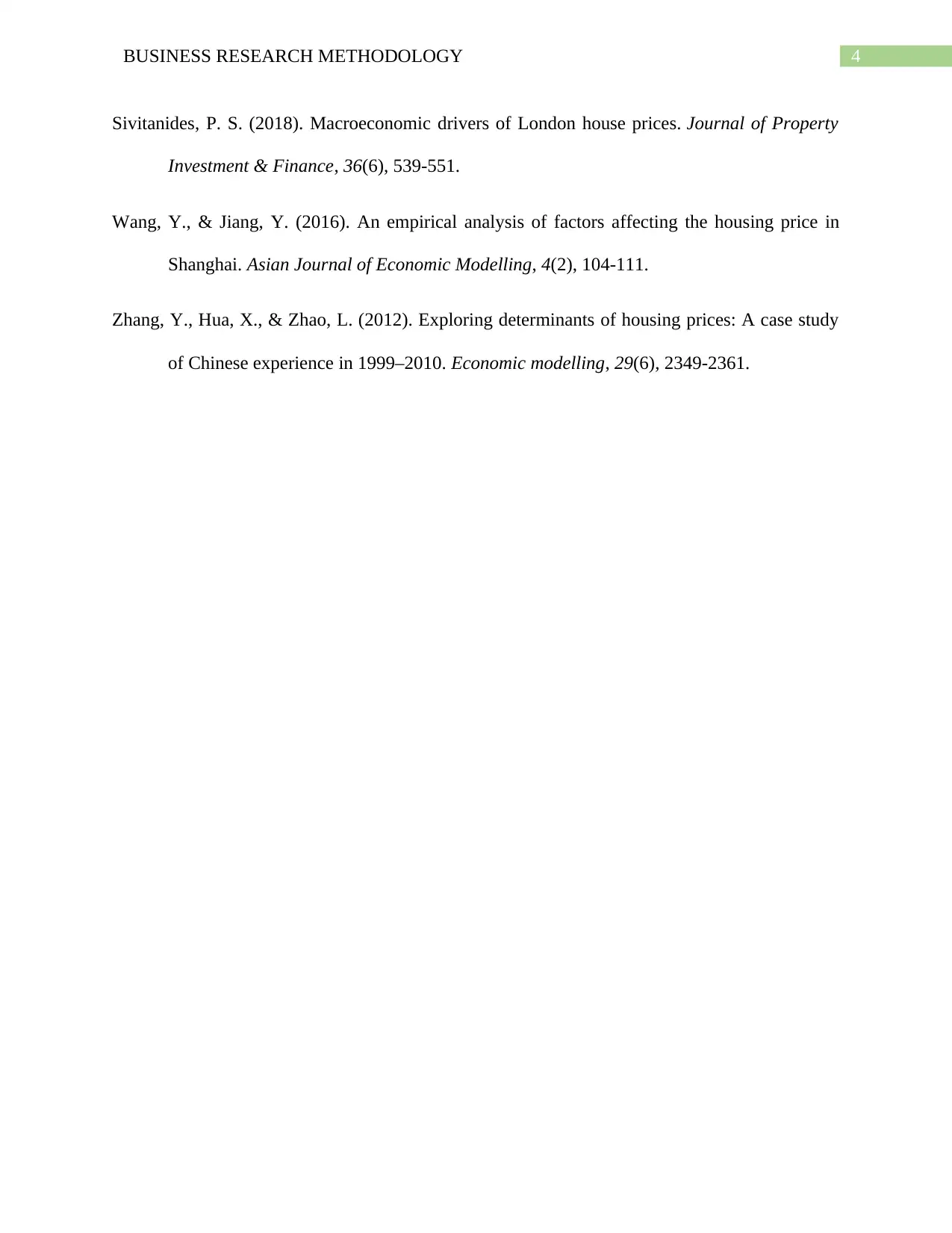
4BUSINESS RESEARCH METHODOLOGY
Sivitanides, P. S. (2018). Macroeconomic drivers of London house prices. Journal of Property
Investment & Finance, 36(6), 539-551.
Wang, Y., & Jiang, Y. (2016). An empirical analysis of factors affecting the housing price in
Shanghai. Asian Journal of Economic Modelling, 4(2), 104-111.
Zhang, Y., Hua, X., & Zhao, L. (2012). Exploring determinants of housing prices: A case study
of Chinese experience in 1999–2010. Economic modelling, 29(6), 2349-2361.
Sivitanides, P. S. (2018). Macroeconomic drivers of London house prices. Journal of Property
Investment & Finance, 36(6), 539-551.
Wang, Y., & Jiang, Y. (2016). An empirical analysis of factors affecting the housing price in
Shanghai. Asian Journal of Economic Modelling, 4(2), 104-111.
Zhang, Y., Hua, X., & Zhao, L. (2012). Exploring determinants of housing prices: A case study
of Chinese experience in 1999–2010. Economic modelling, 29(6), 2349-2361.
1 out of 5
Related Documents
Your All-in-One AI-Powered Toolkit for Academic Success.
+13062052269
info@desklib.com
Available 24*7 on WhatsApp / Email
![[object Object]](/_next/static/media/star-bottom.7253800d.svg)
Unlock your academic potential
Copyright © 2020–2025 A2Z Services. All Rights Reserved. Developed and managed by ZUCOL.




